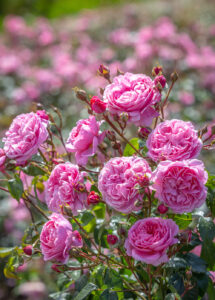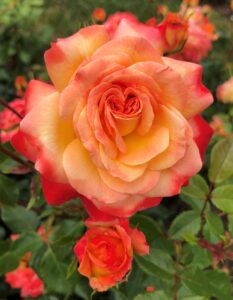You can’t have failed to notice the change in the weather due to climate change. Last summer a lot of my garden frazzled in the dry heat and I didn’t feel that I could water it due to the drought. It recovered again in September, once we had rain, and then we seemed to get never-ending rain during last winter. It never stopped here. This was followed by a really cold spring that saw off lots of my penstemons, crocosmias and salvias. This year’s different again. We got the heat in June instead, but that’s been followed by unseasonably cool and wet weather. My garden’s sulking and so am I.
However, everyone I know has commented on how fabulous their roses have been this summer – despite the British weather. I’ve never known them better. I’m a big fan of roses and I grow ones that only flower in June, because they drip with flower, as well as repeat-flowering roses that have a second flush later on. The latter ration out their flowers, so they are never quite as abundant as the ones that only flower in summer. You need to grow both types of roses, so that June is spectacular.
The summer-flowering ‘once and only once’ roses don’t need to be dead-headed and some develop pretty hips. You can follow them up with a viticella clematis planted close by. It will scramble through and then you’ll get three months of flower. I am very fond of a soft-apricot rambler named ‘Goldfinch’, one of the less aggressive and less thorny ramblers, planted with the July-flowering purple-blue ‘Etoile Violette’. There are lots of excellent viticellas on offer and they’re easy to prune – just cut them back hard in mid-February.

Roses are very drought tolerant and hardy, because many of the species used in rose breeding come from places where summers are hot and winters are cold. Rose chinensis, the China rose, introduced repeat-flowering into modern roses. Other rose species grow naturally in the Middle East and the Mediterranean area. As a result of their natural provenance, roses can tolerate summer heat and drought and most of them are also hardy.
There’s one proviso about drought-tolerance. They have to get their roots down into the ground. If you plant bare root roses, during winter, their woody roots are in contact with the soil as soon as they are planted. These roses romp away, but should a newly planted bare-root rose look as though it’s flagging in its first summer, gently tip a bucket of water over the roots once or twice a week. Don’t dribble a hose over the soil. It brings the roots to the surface and the rose suffers even more.
It’s different matter, if you buy a splendid potted rose in full flower though. Trevor White Roses, a very good supplier of roses, advises that potted, or containerised, roses need to be watered daily in the growing season to ensure good health and maximum blooms. Peter Beales, another fine rose supplier, also says that you should wait until early June before planting potted roses out into the garden. This allows the root system to get established without damaging the young fibrous roots.
Care has to be taken, because roses are field-grown. They are lifted bare-root in winter, then potted on and then sold. There are advantages, because it’s much easier to fall in love with a flowering rose in a pot than a leafless, stick-like plant. When you order bare root roses, they take several weeks to arrive and, more often than not, the weather is against you. You can plant them in freezing weather. You can normally get a container-grown rose within 3 – 5 days and they are beautifully packed. They make excellent presents.

Some gardeners have been put off the nation’s favourite flower, because they imagine having to spray for blackspot and aphids. Aphids can be a problem on the new growth and rose buds in late spring and early summer. However, blue tits and wrens collect them for their fledglings. Ladybird adults and larvae devour them. I’ve seen scorpion flies eating them here and lacewing larvae too. If you spray your roses, you kill these aphid predators as well. You’ll probably end up with more aphids as a result, because there are no creatures left to eat them. Rub them off with your fingers if they really offend you.
When it comes to blackspot, there are plenty of roses that never suffer from this unsightly disease. Some roses, close to species type, hardly ever suffer and this includes many including gallica, alba and rugoa roses. Rambling roses usually miss it too. I’ve just invested in a dark-pink Wichurana rambler named ‘Minnehaha’. Like many ramblers, it dates from the early 20th century. I kept seeing this rose in local gardens so when I visited the Hampton Court Flower Festival, I snapped one up from Peter Beales, another great rose supplier.
Black spot is becoming much less of a problem, because rose breeders are putting health and vigour first these days. David Austin, who was also exhibiting at Hampton Court, launched a new rose raised at the Albrighton nursery. It really took my eye and fellow rose enthusiast, Mary Berry, was also impressed. ‘Penelope Lively’ is named after the Booker Prize winning author and David Austin Junior told me that Penelope Lively, a keen gardener, had mentioned his father in her memoir Life in the Garden. She wrote that the ‘two central activities in my life – alongside writing – have been reading and gardening.”

‘Penelope Lively’ is a lovely rose with clusters of mid-pink, cupped flowers that fade to lavender-pink. The classic rose fragrance has twists of raspberry, lemon and a whisper of myrrh. Harkness Roses, also at Hampton, launched a pale-pink bee-friendly climber called ‘Sense and Sensibility’ at this year’s Chelsea Flower Show. Philip Harkness, the 4rd generation of the Hertfordshire-based rose nursery, really rates this rose. I’m also very fond of another pink Harkness climber launched in 2002, ‘Sweet Syrie’. The fully petalled flowers have a slight yellow flush.
Rose breeding is a time-consuming thing. Hundreds of seedlings are planted into a field and then assessed. The very best of them are bulked up in numbers and this process takes nine years on average, before there are enough roses to make it worthwhile to launch. The Rose of the Year 2024 is named ‘Meteor’ and it was bred by a Kordes Roses of Germany. It’s one of those sunset-coloured roses with yellow bloom suffused in red. It repeat-flowers and reaches between 2 and 3 feet (up to 70cm) high, so it’s an ideal rose for a smaller garden. Modern roses tend to be bushy and compact.

This year’s Rose of the Year is a short climber named ‘Peach Melba’ and it’s a soft mixture of apricot and pink. I planted two last year and watered them for most of last summer and it has paid dividends. I like these sunset-coloured roses, especially near blues. David Austin’s ‘Lark Ascending’ is an airy rose with large clusters of loosely arranged semi-double flowers. It’s hardly every without a flower, because it sends up new ones as the cluster above fades.
Also new to me is a healthy shrub rose named ‘Rosy Cushion’. It’s rather like a large, but superior, dog rose, with clusters of pale-centred single-pink flowers. It’s another rose that’s hardly ever out of flower, but this one’s forms a four-foot high and wide roundel (1.2m).
The best thing about them all: they’ll shrug off heat and drought once the roots are down. And I think the writing’s on the wall. We’re going to get erratic weather in the future!



